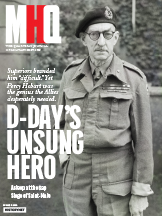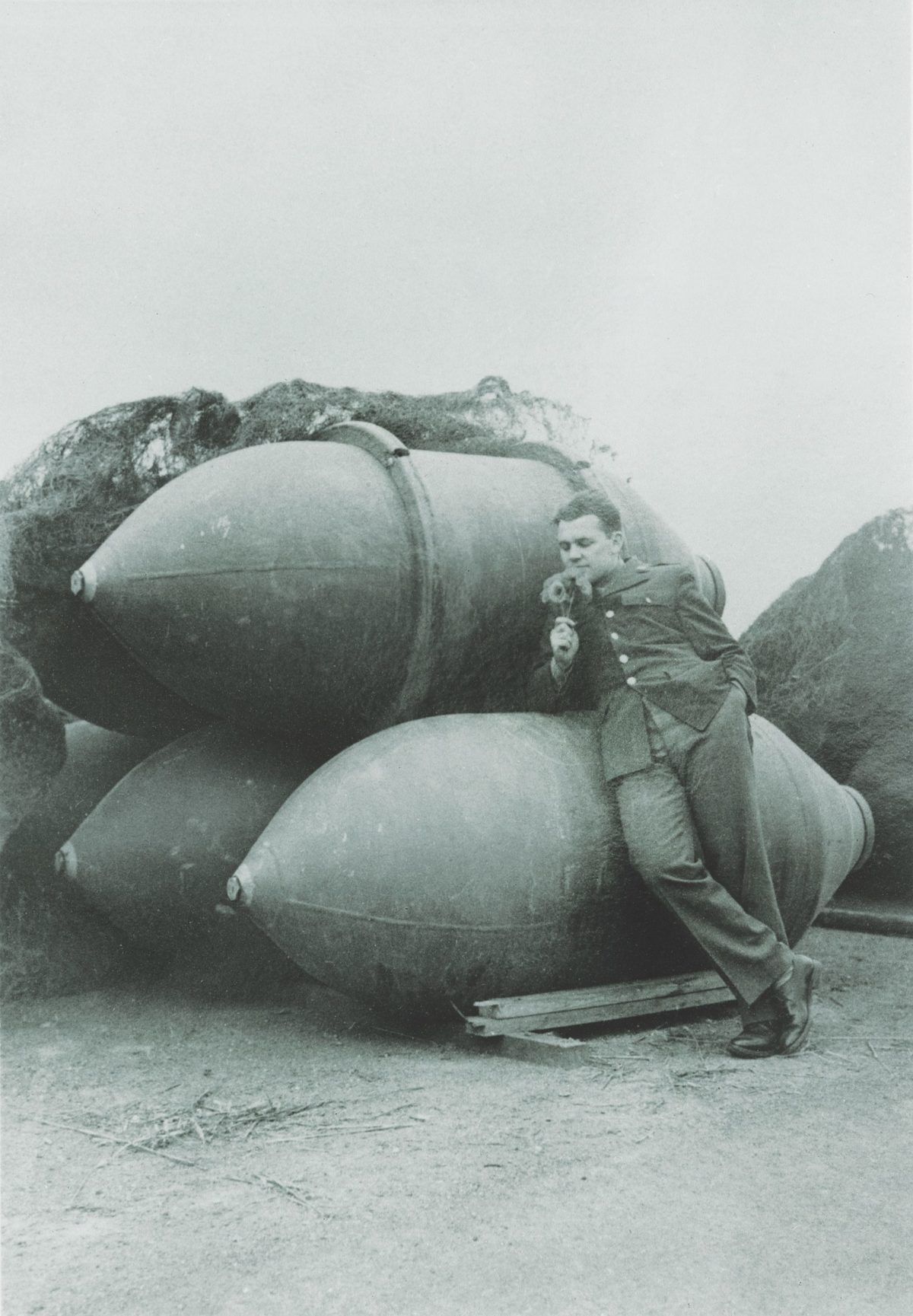When Andy Rooney died in 2011 at age 92, he was probably best known for his folksy, often cranky commentaries for the CBS television program 60 Minutes. (The 1,097th installment of “A Few Minutes with Andy Rooney,” the show’s closing segment, had aired a month earlier.) But Rooney’s debut as a journalist came in 1942, just a year after he was drafted into the U.S. Army for service in World War II, when he signed on as a reporter for the military newspaper Stars and Stripes.
“They needed reporters and newspaper people,” Rooney recalled in an interview in 2006. “I lied and said I was one and got the job and held on until I learned how to do it. And it was probably the single most fortuitous event in my life because I got to go everywhere. I saw the war like nobody—very few people saw World War II as I did because there was nowhere I couldn’t go.”
Soon Rooney would fly on dangerous combat missions with the Eighth Air Force, follow Allied troops ashore at Normandy after D-Day, witness the U.S. First Army’s breakout at Saint-Lô, cross the Ludendorff Bridge after the 9th Armored Division captured it, join the triumphal march into Paris, and become one of the first American journalists to write about Nazi concentration camps. He returned home as the only war correspondent to have been awarded the Bronze Star Medal and the Air Medal for having flown five combat missions.
In February 1943 Rooney, who had just turned 23, was one of seven reporters—and the youngest among them—who flew on the second U.S. bombing raid over Germany. “I got in my bomber,” he later recalled, “and I thought to myself, ‘Why am I doing this? I’m scared to death. I mean, I don’t have to risk my life’—except that I felt so bad for all the men who did have to risk their lives all those times that it just seemed like it was the honest thing to do.”
Rooney later said that he ended up with the best story of the day “because my bomber was hit.” Here it is, as published in the European edition of Stars and Stripes on February 27, 1943.
A U.S. BOMBER STATION, February 26—From the nose of Lieutenant Bill Casey’s Banshee, I saw American [B-17 Flying] Fortresses and [B-24] Liberators drop a load of destruction on Wilhelmshaven today.
We flew to Germany in the last group of a Fortress formation and Banshee was in the trailing squadron.
Soon after dawn the bombers thundered down the runway. Lieutenant Casey’s windshield was splattered with mud on the way. It really was a blind take-off.
Like a pickup football team on a Saturday morning, we grew in strength as we flew, until all England seemed to be covered with bombers.
Everything was quiet—almost monotonous—for an hour after we left the English coast.
Then the trouble began.
Peeling out of the sun came shining silver German fighter planes, diving at one bomber in the formation and disappearing below the cloudbanks as quickly as they had come. They seemed tiny, hardly a machine of destruction, and an impossible target.
My first glimpse of a German fighter came when the navigator, Second Lieutenant William H. Owens, of Tullahoma, Tennessee, nearly knocked me into the lap of Second Lieutenant Malcolm A. Phillips Jr., the bombardier, whose home is in Coffeyville, Kansas. Owens swung around at what appeared to be an Me109 as it whipped down through the clouds on our left.
From that time until three and one-half hours later, when we were halfway home, no one had to look far to see a German fighter. They were all over and they were all kinds of planes—Me109s, Ju88s, and Me110s. There were no FW190s, by far the best plane Jerry has to fight the Forts. Their absence strengthened Allied contentions that Germany is desperately short of fighter planes.
From a vantage point in the pilot’s cabin Lieutenant Casey and his co-pilot, First Lieutenant Kelly G. Ross, were calmly giving information over the intercom.
“Here comes one at 2 o’clock, Elliot. Get the son-of-a-bitch.”
Technical Sergeant Wilson C. Elliot, of Detroit, Lieutenant Casey’s top turret man, is the only man from the original Banshee crew left.
Before we were very deep into Germany deadly black puffs began to appear around us. It seemed as though they were “air mines” that were touched off as we came to them. A puff would appear to our right and then in quick succession a row of five more black splotches flowered out, each one closer as they caught up to us.
Lieutenant Casey zigged, and the puffs appeared in the tracks of our zag. He was one jump ahead of the flak. All but once he was one jump ahead.
Lieutenant Phillips was leaning far forward in the nose, between his guns and bomb-sight, when suddenly the whole nose seemed to break out of the ship. My first impression was that they had given up the flak and had thrown the gun at us.
Lieutenant Phillips sat back on his heels and covered his eyes with his hands. Splinters of flexiglass formed a coating over his helmet. It was a minute before he recovered from the shock to open his eyes and find that he could see and was unhurt.
What appeared to be the nose being ripped off actually was only a small hole the size of a man’s fist.
The formation was perfect, and the German sky dotted with Forts in front of us and Liberators behind us was comforting. Below, the land seemed to be farmland for the most part. Even that was divided into aggravatingly square plots. It looked German and unfriendly. You had the feeling you would have known it was Germany even if you hadn’t attended the briefing.
German flak didn’t seem to bother German fighter planes. They poured in even when their own flak was thickest.
Approaching the bombing run, the doors of the ships in front of us could be seen swinging open, and not far above us the yawning bomb bay of a Fort revealed more bombs, hanging by some mechanical hairpin, waiting for the bombardier to push the tiny button that sends them to the target.
Lieutenant Owens was having trouble with his oxygen and Lieutenant Phillips’s fingers were nearly frozen. I was healthy but helpless. Finally the valve of the navigator’s air intake froze completely and the next thing his head had dropped to the top of his caliber .50, and his face was an unlovely greyish purple. Both of them had work to do in the nose. I was strictly cargo. The oxygen on my side was okay. We fitted the mask to Lieutenant Owens’s face, revived him, and I started back for the pilot’s cockpit.
By the time I struggled back without oxygen, with a backload of equipment that would make Santa Claus look sick, I was almost out. Lieutenant Casey almost yawned at what I was sure was a major crisis in my life.
He fixed me up with oxygen and the remainder of my brief first glimpse at the war was from the pit behind the pilot.
As we started the bombing run I was up in the nose of the ship, standing over to the right trying to keep out of the way of the navigator and bombardier. I had a camera, and that was probably the greatest underestimation, or something or other, of the Germans anyone ever made. I definitely did not feel like taking pictures. I made an effort once or twice and I got a couple of pictures of a small bunch of six little ships down on the water, but it’s elementary that you have to be able to hold a camera still to take pictures.
We were well into the run and the flak was puffing to the right and left. The boys said it was not nearly as intensive as over St. Nazaire, but there was more of it, spread out in different places, they said.
Fighter planes were always there while we were making our run. They come in so fast it’s hard to tell where they’re coming from, but frequently you could see a vapor trail start to form, like a cloud standing on end. You knew that was a fighter starting a run.
As the bombardier crouched low over his sight, I was just in back of him, trying to take a picture of the bombs falling from the plane ahead. They dropped theirs, and I guess we must have the next second but I couldn’t feel it.
Behind the tail gunner, Technical Sergeant Parley D. Small, of Packwood, Iowa, reported that he had seen a Liberator go down with one engine flaming. Although it was on fire he said it was under control for a crash landing. Small himself picked off one German plane as it tried to tie a stream of machine-gun bullets on our tail. He described the end of another German fighter.
“It looked like a piece of cardboard that had been thrown out of a plane,” he said. “It came up under the belly of a B24 and someone let him have it right on the nose. He stopped dead and fell away. The plane didn’t seem to be burning. It must have killed the pilot.”
As Nazi planes kept nipping at the formation, far away from the coast of Germany, they probably picked us up from the French coast. It is improbable that German-based fighters followed the USAAF bombers that far, even though many of them seemed to be twin-engined planes.
Almost halfway home, three Ju88s could be seen diving at a B24 that had fallen out of formation and was in distress.
After 20 minutes without sign of Jerry, things began to look more pleasant.
Lieutenant Casey and the crew began to sing over the intercom. Casey had the bends and was squirming in his seat—but smiling and singing. Next to him, Lieutenant Ross had to do most of the flying on the way home. Finally England was sighted and believe me, whatever you think, it is one of the most beautiful islands in all the world.
As Lieutenant Casey says, “I’m an Irishman, southern Ireland, but that is still the best looking damned little island I ever saw.”
After a roof-lifting “buzz” (hedge-hopping) over the field, not orthodox, Lieutenant Casey brought the ship in smoothly.
Looking over the Banshee, we found that it had been hit in about 10 places. The biggest hole was a gaping wound in her metal near the tail gunner. The chip of flak tore a hole through an English penny that Sergeant Small had left on the floor behind him.
With the exception of one frozen finger—Lieutenant Phillips’s—the Banshee had what the crew called “a quiet trip.”
I don’t want to go on a noisy one. MHQ
[hr]
This article appears in the Summer 2019 issue (Vol. 31, No. 4) of MHQ—The Quarterly Journal of Military History with the headline: Classic Dispatches | How it Feels to Bomb Germany

Want to have the lavishly illustrated, premium-quality print edition of MHQ delivered directly to you four times a year? Subscribe now at special savings!





